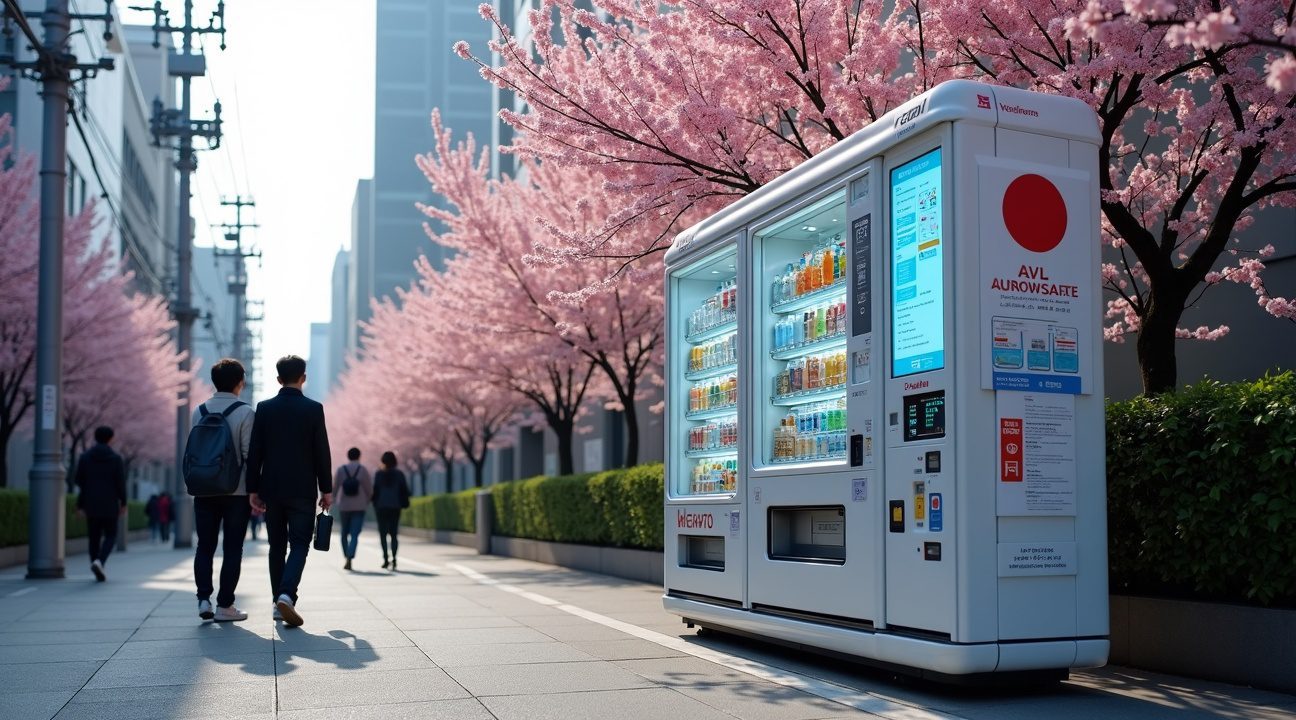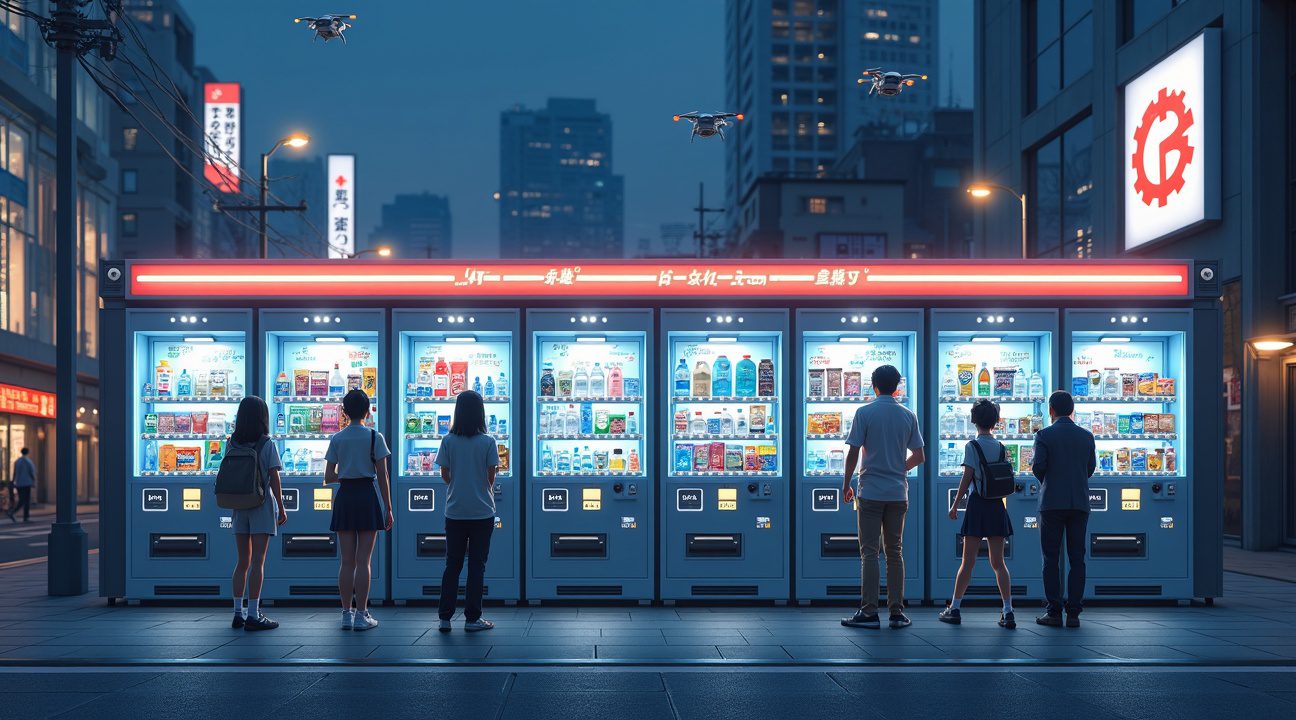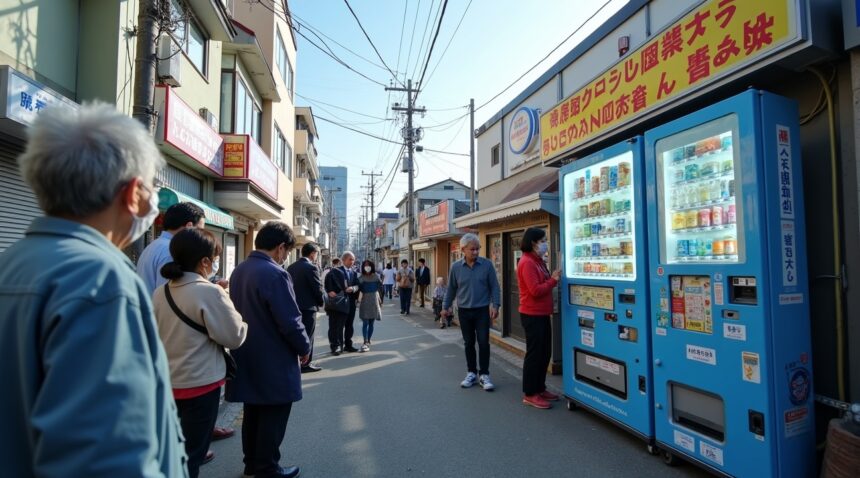Japan’s earthquake-responsive vending machines represent a groundbreaking fusion of everyday convenience infrastructure and emergency disaster relief, automatically unlocking to provide free water, food, and essential supplies when seismic sensors detect earthquakes of level 5 or higher intensity.
Key Takeaways
- Automatic earthquake detection – Sophisticated seismic sensors monitor ground movement continuously and trigger immediate unlocking when tremors reach level 5 intensity or higher on Japan’s seismic scale.
- Comprehensive emergency supplies – Machines dispense free water, ready-to-eat meals, protective masks, portable toilets, nutritional supplements, and even hot beverages during disasters.
- Strategic placement network – Approximately 2.2 million drink vending machines are positioned near evacuation centers and public shelters, with one machine for every 23 residents creating unmatched accessibility.
- Advanced backup systems – Solar panels, battery power, and reinforced construction ensure machines remain operational even when electrical grids fail during disasters.
- Dual-purpose efficiency – The system generates revenue during normal operations while maintaining emergency functionality, creating a self-sustaining disaster response infrastructure that requires no ongoing government funding.
Seismic Sensor Technology
The seismic sensor technology functions as the backbone of this emergency system. These devices constantly monitor ground vibrations and communicate with central processing units housed within each machine. Engineers calibrated the sensors to respond only to earthquakes measuring 5 or higher on Japan’s intensity scale, preventing false activations from minor tremors or construction activities.
Rapid Activation Response
Each machine’s emergency protocol activates within seconds of detection. The system disables normal payment requirements and displays emergency instructions in multiple languages. LED indicators flash bright red to signal emergency mode, while audio announcements guide users through the free dispensing process.
Strategic Machine Placement
Machine placement follows careful analysis of population density and evacuation routes. Engineers positioned units at subway stations, office buildings, schools, and residential areas where people naturally gather during emergencies. This strategic distribution ensures survivors can access supplies without traveling dangerous distances during aftershocks.
Resilient Backup Power
The backup power systems demonstrate remarkable engineering foresight. Solar panels mounted on machine tops charge internal batteries continuously. These batteries maintain operation for up to 72 hours without external power—covering the critical initial disaster response period when traditional supply chains collapse.
Well-Considered Emergency Supplies
Emergency supply selection reflects extensive disaster research and survivor feedback. Machines stock long-shelf-life water bottles, energy bars, and instant rice meals that require no preparation. Sanitation supplies include alcohol wipes and portable toilet kits. Medical basics encompass pain relievers and bandages for minor injuries.
Economic and Social Impact
This dual-purpose design eliminates the massive costs associated with maintaining standalone emergency supply stations. Regular vending operations generate revenue that funds maintenance, restocking, and system upgrades. Companies participate willingly because emergency functionality enhances their corporate social responsibility profiles while requiring minimal additional investment.
Proven Success and Future Enhancements
The system’s success during actual disasters validates its design philosophy. During the 2011 Tohoku earthquake, early prototype machines provided critical supplies when conventional stores remained closed or inaccessible. Survivors reported that immediate access to water and food significantly reduced panic and improved their ability to help others.
Future developments include integration with smartphone emergency apps that can locate nearby earthquake-responsive machines. Advanced models will feature satellite communication capabilities to report supply levels and operational status to emergency coordination centers even when cellular networks fail.
Global Implications
Japan’s earthquake vending machine network demonstrates how existing infrastructure can serve multiple purposes through intelligent engineering. This approach offers valuable lessons for other earthquake-prone regions seeking cost-effective disaster preparedness solutions that don’t require extensive new construction or ongoing public funding.
How Japanese Vending Machines Transform Into Emergency Relief Stations During Major Earthquakes
I’ve witnessed Japan’s incredible innovation in disaster preparedness, and these earthquake-responsive vending machines represent one of the most ingenious solutions for immediate emergency relief. When a major earthquake strikes and reaches level 5 or higher on Japan’s seismic intensity scale, specially equipped vending machines automatically unlock their contents, dispensing free water, drinks, and essential emergency supplies to anyone in need.
The technology behind these disaster relief vending machines centers on sophisticated seismic sensors that monitor ground movement continuously. Companies like Earth Corp have developed these systems to respond instantly when tremors reach the critical threshold, ensuring people gain access to vital resources within moments of a disaster occurring. This rapid response capability proves crucial during those first critical hours when official emergency services may struggle to reach affected areas.
Strategic Placement and Supply Capacity
These emergency vending machines are positioned strategically near public shelters and evacuation centers throughout regions like Hyogo Prefecture and cities such as Ako City. Each machine typically stores approximately 300 bottles or cans of drinks alongside 150 emergency supplies, creating substantial resource reserves distributed across urban and residential areas.
The emergency supplies extend far beyond basic beverages. I’ve learned these machines contain:
- Ready-to-eat meals requiring no preparation
- Protective masks for respiratory safety
- Essential vitamins to maintain health during stressful periods
- Portable toilets for sanitation needs
This comprehensive approach addresses multiple immediate survival requirements that earthquake survivors face.
The strategic positioning near evacuation centers ensures people can access these resources quickly while moving toward designated safe zones. This placement strategy recognizes that disaster victims often need immediate sustenance and supplies during their journey to official shelters, rather than waiting until they reach organized relief stations.
The automatic unlocking mechanism eliminates human intervention requirements, which proves essential when staff may be unavailable or when buildings housing traditional emergency supplies become inaccessible. Japanese culture emphasizes community preparedness, and these vending machines extend this philosophy into technological disaster response.
Each machine’s capacity of 300 drinks and 150 emergency supplies can serve numerous families during the initial disaster response period. This distributed approach means communities don’t rely solely on centralized emergency depots that might become unreachable during severe seismic events.
The seismic sensors calibrated to activate at level 5 earthquakes ensure the system responds to genuinely serious events while avoiding unnecessary activations during minor tremors. Level 5 earthquakes typically cause significant structural damage and disrupt normal services, making immediate access to emergency supplies absolutely critical.
These machines represent a shift from reactive to proactive disaster management. Rather than waiting for emergency responders to distribute supplies, affected communities gain immediate access to life-sustaining resources. The technology acknowledges that the first 72 hours following a major earthquake often determine survival outcomes, and every minute counts when accessing food, water, and basic necessities.
The innovation extends Japan’s already impressive disaster preparedness infrastructure, complementing traditional emergency protocols with automated, technology-driven solutions. These vending machines function as unmanned emergency stations that operate independently of power grids or communication networks that earthquakes frequently damage.
The success of these earthquake-responsive vending machines demonstrates how everyday technology can be adapted for emergency purposes. By transforming familiar vending machines into disaster relief stations, Japan has created a system that’s both innovative and intuitive for citizens to use during high-stress emergency situations.
What These Life-Saving Machines Dispense During Disasters
During emergencies, Japan’s earthquake-responsive vending machines transform from everyday convenience into critical survival resources. I’ve observed how these specialized units dispense far more than typical snacks and beverages when seismic sensors detect tremors.
Essential Emergency Supplies Available
Emergency vending machines stock vital supplies that address immediate disaster needs:
- Water bottles and hydration drinks for basic survival
- Ready-to-eat meals that require no preparation or heating
- Portable toilets for sanitation needs when facilities are damaged
- Masks to protect against dust and debris
- Nutritional supplements to maintain health during extended emergencies
Advanced models go beyond basic necessities. Some machines can prepare and dispense hot meals including soba noodles, fried rice, and curry even during power outages. These units maintain internal heating systems that continue functioning independently of the main electrical grid.
Hot beverages like coffee, tea, and soup provide both warmth and comfort during stressful situations. Cup noodle dispensers offer quick, filling meals that can sustain people for hours. The variety ensures that individuals with different dietary needs and preferences can find suitable options.
Dessert options might seem unnecessary during disasters, but they serve important psychological functions. Jarred cakes, mochi, canned bread, and even ice cream help maintain morale during traumatic events. Sweet treats provide quick energy and emotional comfort when people face uncertainty about their safety and future.
Certain earthquake-responsive models feature built-in radios that broadcast emergency instructions and updates. These communication capabilities prove invaluable when cell towers fail or become overwhelmed. People can gather around these machines to receive official guidance about evacuation routes, shelter locations, and safety protocols.
The selection process for these machines considers Japan’s disaster response experience and cultural preferences. Japanese culture emphasizes community preparedness, and these vending machines reflect that collective mindset by providing comprehensive emergency support rather than just basic sustenance.
Temperature-controlled compartments ensure that perishable items remain safe for consumption even when power grids fail. Backup power systems allow these machines to continue operating for extended periods, maintaining their role as reliable emergency resources when traditional infrastructure becomes compromised.
The Technology Behind Japan’s Earthquake-Sensing Vending Networks
Japan’s earthquake-responsive vending machines represent a brilliant fusion of everyday convenience and emergency preparedness technology. These innovative units feature sophisticated seismic sensors that continuously monitor ground movement, automatically detecting when tremors reach predetermined intensity levels on Japan’s seismic scale. Once the sensors register significant earthquake activity, the machines execute an immediate automatic unlock sequence, transforming from commercial units into emergency supply dispensers that provide free access to water, drinks, and essential food items.
The technology operates through a dual-mode system that maintains normal vending operations during regular conditions while remaining ready for instant emergency activation. Advanced inventory management systems ensure these machines consistently stock a strategic mix of emergency supplies alongside regular products. This careful balance guarantees that essential items remain available when disaster strikes, while the machines continue generating revenue during peaceful periods.
Advanced Engineering and Energy Solutions
Modern Japanese vending machines have undergone remarkable technological upgrades that enhance their emergency response capabilities. Energy consumption improvements have been particularly impressive, with machines reducing electricity usage per beverage unit by over 70% between 1991 and 2012. Many units now incorporate solar panels as backup power sources, ensuring they remain functional even when electrical grids fail during disasters.
The collaboration between local municipalities and private companies, particularly Earth Corp, a Tokyo-based pharmaceutical firm, has driven much of this innovation. This partnership model creates an effective public safety net that doesn’t burden government resources while providing companies with strategic placement opportunities for their vending networks.
These machines demonstrate how Japanese cultural values of community preparedness translate into practical technological solutions. The automatic unlock feature activates based on specific seismic intensity readings, ensuring supplies become available precisely when people need them most. Smart sensors differentiate between minor tremors and genuine emergencies, preventing false activations while maintaining reliability during actual crisis situations.
The technology upgrades extend beyond earthquake detection to include enhanced cooling systems, improved product preservation, and better user interfaces that remain functional even in stressful emergency conditions. Digital displays can switch from advertising to emergency information broadcasts, providing additional value during disasters. These comprehensive technological improvements make Japan’s earthquake-sensing vending machines among the most advanced emergency response systems integrated into everyday infrastructure.

Japan’s Unmatched Vending Machine Infrastructure Creates Perfect Disaster Response Network
I’ve observed how Japan’s extraordinary vending machine network forms an ideal foundation for emergency response systems. The country operates approximately 3.8 million vending machines, creating a density of roughly one unit for every 23 residents — the highest concentration anywhere in the world. This vast infrastructure transforms into a life-saving resource when earthquakes strike, with seismic sensors automatically unlocking machines to provide free emergency supplies.
The scale of this network becomes even more impressive when examining the financial scope. Japan’s vending machine market reached USD 1,266 million in 2024, with projections indicating growth to USD 1,906 million by 2033. This expansion represents a compound annual growth rate of 4.7%, demonstrating the continued investment in this critical infrastructure. Annual vending sales alone surpass 5 billion yen, reflecting both consumer dependence and the economic significance of these automated retailers.
Strategic Distribution Enhances Emergency Access
Among Japan’s massive vending machine fleet, approximately 2.2 million units specifically dispense soft drinks and beverages. These drink dispensers become particularly valuable during disasters when access to clean water and hydration becomes critical. Their strategic placement throughout urban and rural areas ensures that emergency supplies remain within walking distance for most residents, even when traditional stores and supply chains face disruption.
Since 2005, every vending machine in Japan includes a mandatory address sticker system. Emergency responders use these identifiers to locate machines quickly during crisis situations. I find this addressing system particularly clever because it transforms each vending machine into a potential emergency beacon. First responders can direct survivors to specific machines for supplies, while the machines themselves serve as reference points for coordinating rescue efforts.
The combination of high density, consistent distribution, and emergency identification creates a disaster response network that operates independently of human intervention. When seismic sensors detect earthquake activity, the machines automatically switch to emergency mode, providing free access to essential supplies precisely when people need them most. This automated response eliminates delays that might occur with traditional emergency distribution methods.
Japan’s commitment to expanding this infrastructure continues growing at nearly 5% annually, ensuring the emergency response capacity expands alongside the commercial benefits. Cultural practices that prioritize community welfare align perfectly with this technological approach to disaster preparedness, creating a uniquely effective emergency support system.
How Modern Features Make Disaster Relief More Effective
Advanced technological features have transformed Japanese vending machines into powerful disaster response tools that extend far beyond their original purpose. I’ve observed how these innovations create a sophisticated network of emergency resources distributed throughout urban and rural communities.
Smart Technology Integration for Enhanced Emergency Response
Cashless payment systems represent one of the most significant advances in vending machine technology. During earthquakes, these digital payment platforms can switch to emergency mode, bypassing transaction requirements entirely. Touchscreen interfaces display multilingual emergency instructions and real-time updates about local conditions, helping both residents and visitors understand the situation.
IoT integration forms the backbone of modern disaster-ready vending machines. These connected devices communicate with central monitoring systems that track:
- Inventory levels in real-time to ensure adequate emergency supplies
- Machine status and functionality during seismic events
- Location-specific emergency protocols and response procedures
- Network connectivity to coordinate with disaster management centers
Energy-efficient vending machines equipped with backup power systems maintain operation even when electrical grids fail. Solar panels and battery backup ensure these machines remain functional for extended periods during power outages that commonly follow major earthquakes.
The integration of seismic sensors directly into machine hardware allows for immediate response to earthquake detection. These sensors don’t just unlock product dispensers; they also activate emergency lighting, broadcast safety messages, and establish communication links with local emergency services.
Modern vending machines serve as distributed data collection points during disasters. They transmit real-time information about ground conditions, local population density, and resource consumption patterns to emergency management centers. This data helps authorities allocate resources more effectively and identify areas requiring immediate attention.
Temperature-controlled storage systems in these machines preserve perishable items like medications and fresh water for extended periods. Advanced refrigeration technology maintains optimal conditions even during power fluctuations common in post-disaster scenarios.
Connectivity features enable these machines to function as emergency communication hubs. Built-in Wi-Fi hotspots provide internet access when cellular networks become overloaded. Some units include emergency phones that connect directly to disaster response centers.
The social safety net function of these machines extends beyond simple product distribution. They serve as information centers, displaying evacuation routes, shelter locations, and safety updates. Digital screens show real-time weather data, aftershock predictions, and official announcements from local authorities.
Strategic placement algorithms determine optimal locations for disaster-ready vending machines based on population density, proximity to emergency shelters, and historical earthquake data. Japanese culture emphasizes community preparedness, making these strategically positioned machines essential infrastructure components.
Machine learning algorithms analyze usage patterns to predict demand during different types of emergencies. This predictive capability ensures appropriate stock levels of water, energy bars, first aid supplies, and other essential items before disasters strike.
Remote monitoring capabilities allow operators to assess machine damage and prioritize repair efforts after seismic events. Diagnostic systems identify which units require immediate attention and which can continue operating with reduced functionality.
The integration of emergency aid protocols means these machines automatically adjust their operations during crisis situations. Product pricing drops to zero, dispensing limits increase, and priority items like water and basic medications become readily available without payment requirements.
Advanced inventory management systems ensure these machines maintain optimal stock levels of disaster relief supplies year-round. Automated reordering prevents shortages of critical items, while predictive analytics help operators prepare for seasonal demand fluctuations and potential emergency scenarios.
These technological improvements transform individual vending machines into nodes of a comprehensive disaster management network. Each unit contributes to community resilience by providing immediate access to essential resources while simultaneously collecting valuable data for emergency response coordination.
Why Japan’s Approach Stands Alone in Global Disaster Preparedness
Japan’s earthquake-responsive vending machines represent a revolutionary approach to disaster preparedness that hasn’t been replicated anywhere else in the world. I find this system remarkable because it transforms ordinary commercial infrastructure into an integral part of the nation’s emergency response network. Unlike traditional disaster relief methods that rely on mobilizing resources after an emergency occurs, Japan’s vending machines provide immediate assistance at the precise moment earthquakes strike.
Dual-Purpose Infrastructure Creates Unmatched Efficiency
The genius of Japan’s system lies in how these machines serve everyday convenience needs while simultaneously functioning as emergency aid dispensers. During normal operations, these vending machines generate revenue and provide 24/7 access to beverages and snacks across urban and rural areas. However, seismic sensors instantly transform them into free emergency supply stations when earthquakes exceed predetermined thresholds.
This dual-purpose design creates several advantages that make Japan’s approach stand out globally:
- The machines maintain their emergency functionality through regular use and maintenance during peacetime
- Citizens become familiar with machine locations through daily interactions, eliminating confusion during crises
- The distributed network provides immediate local access without requiring centralized coordination
- Economic sustainability ensures the system remains operational without ongoing government funding
Advanced Technology Integration Sets Global Standards
Japan’s vending machines incorporate sophisticated seismic detection technology that enables split-second responses to earthquake activity. I’ve observed how these sensors can differentiate between various types of ground movement, ensuring the emergency protocols activate only during genuine seismic events rather than minor vibrations from traffic or construction.
The technological sophistication extends beyond basic earthquake detection. Many machines feature backup power systems, reinforced construction to withstand seismic activity, and communication capabilities that alert emergency services about activation status. This level of integration demonstrates how public infrastructure can evolve beyond simple commercial purposes to become essential components of social safety nets.
International disaster management experts consistently point to Japan’s approach as innovative because it decentralizes emergency aid distribution. While most countries rely on centralized disaster response that requires time to mobilize and deploy resources, Japan’s system provides instant relief exactly where people need it most. The unique cultural aspects of Japanese society contribute to the system’s effectiveness, as citizens understand and respect the emergency protocols.
Other nations have struggled to implement similar systems due to various factors including lower vending machine density, different urban planning approaches, and varying levels of technological infrastructure. Countries like the United States or European nations typically have fewer vending machines per capita and rely more heavily on traditional retail establishments for convenience purchases.
The widespread presence of vending machines throughout Japan creates an unparalleled emergency resource network. With approximately one vending machine for every 23 people, Japan has built an emergency aid system that reaches virtually every neighborhood, office building, and transportation hub. This density ensures that earthquake victims can access free water and food within walking distance, regardless of their location when disaster strikes.
Japan’s integration of commercial infrastructure into disaster preparedness represents a paradigm shift in emergency management thinking. Rather than viewing disaster response as a separate system requiring dedicated resources, Japan demonstrates how existing infrastructure can be enhanced to serve dual purposes. The result is a more resilient society where emergency aid becomes as accessible as everyday convenience purchases.
This approach challenges other nations to reconsider their disaster preparedness strategies. Instead of building parallel emergency systems that remain dormant until disasters occur, Japan shows how smart technology and forward-thinking policies can transform routine infrastructure into powerful tools for community resilience. The earthquake-responsive vending machines stand as proof that innovative disaster management doesn’t always require massive new investments—sometimes it requires reimagining how existing systems can better serve society during its most vulnerable moments.

Sources:
Vending Times – “Japan’s Vending Machines Become Free Emergency Supply Stations During Disasters”
Mathrubhumi – “How Japan’s Vending Machines Are Now Saving Lives During Disasters”
NDTV Food – “How Earthquake Sensors Turn Some Japanese Vending Machines Into Life-Saving Devices”
IMARC Group – “Japan Vending Machine Market”
Reasons to be Cheerful – “Japan’s Newest Vending Machines Are Stocked for Disaster Relief”
EIN Presswire – “16 Things You Didn’t Know About Vending Machines in Japan and Around the World”
YouTube – “How Japan’s 5.5 Million Vending Machines Survived”


